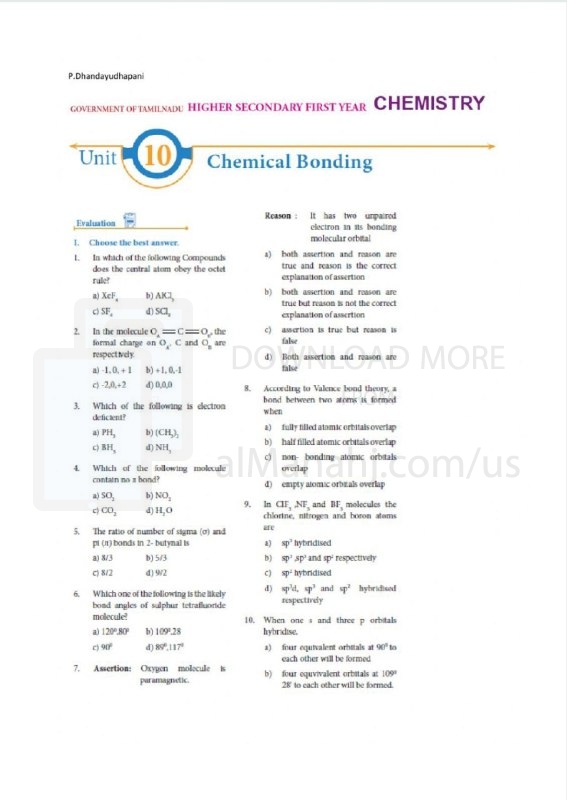| You are here: Almanahj Website ⇒ American curriculum ⇒ 10th Grade ⇒ Chemistry ⇒ Term 1 | ||
|---|---|---|
Worksheet about Chemical bonding | ||
|---|---|---|
| Subject: Chemistry | ||
| 10th Grade | ||
| Term 1 | ||
| Year: 2023/2024 | ||
| Size: 553.7KB | ||
| Number of clicks: 91 | ||
| Publish date:November 05, 2023 | ||
| Added by: Eman | ||
| Last download date: 2024-09-03 15:05:39 | ||
| Updated by: Eman9966 on 2023-11-05 08:37:24 | By: theodor P.Dhandayudhapani | |
File info: A worksheet about chemical bonding is an educational resource that focuses on the fundamental concepts and principles related to the formation and properties of chemical bonds between atoms. It is designed to help students practice and reinforce their understanding of key concepts and theories in chemical bonding. Here's a description of what you can expect in a worksheet about chemical bonding:1. Introduction to Chemical Bonding: - The worksheet may provide an overview of chemical bonding, explaining its significance and how it governs the behavior and properties of substances. - It may cover the different types of chemical bonds, including ionic bonds, covalent bonds, and metallic bonds. 2. Lewis Dot Structures: - Lewis dot structures are diagrams that represent the arrangement of valence electrons in an atom or molecule. - The worksheet may include problems that involve drawing Lewis dot structures for various elements and compounds, allowing students to practice identifying valence electrons and understanding the octet rule. 3. Ionic Bonding: - Ionic bonding involves the transfer of electrons from one atom to another, resulting in the formation of positive and negative ions. - The worksheet may cover topics such as the formation of ionic compounds, the role of cations and anions, and the use of Lewis dot structures to represent ionic bonding. 4. Covalent Bonding: - Covalent bonding involves the sharing of electrons between atoms, resulting in the formation of molecules. - The worksheet may cover topics such as Lewis dot structures for covalent molecules, the concept of electronegativity, and the classification of covalent bonds as nonpolar or polar. 5. Metallic Bonding: - Metallic bonding occurs in metals and involves the delocalization of electrons within a lattice of metal atoms. - The worksheet may cover topics such as the properties of metals, the formation of metallic bonds, and the relationship between metallic bonding and the physical properties of metals. 6. Molecular Geometry and Bonding Theory: - Molecular geometry refers to the three-dimensional arrangement of atoms in a molecule, which is influenced by the type of bonding present. - The worksheet may include problems that require students to determine the molecular geometry of molecules using Lewis structures, VSEPR theory, and valence bond theory. A chemical bonding worksheet provides students with opportunities to apply their knowledge of chemical bonding concepts and theories to solve problems and analyze the properties of substances. It encourages critical thinking, spatial reasoning, and the ability to understand the relationship between bonding and the structure and behavior of molecules and compounds. Teachers often use chemical bonding worksheets as assignments, homework, or in-class activities to assess students' understanding and proficiency in applying chemical bonding concepts. These worksheets also serve as valuable tools for students to practice and reinforce their skills in drawing Lewis dot structures, understanding different types of chemical bonds, and predicting the properties of substances based on their bonding characteristics. | ||
| Downloading link Worksheet about Chemical bonding |
|---|
|
1699172097.pdf
The file is being prepared for download
|
| File images |
|---|
 |